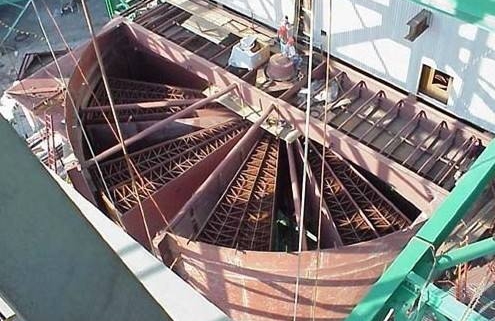1. The phenomenon of dust accumulation in the air preheater
If the air preheater deposits in the operating unit, it will cause the primary and secondary air pressure at the inlet and outlet of the air preheater to swing and rise, the pressure difference between the primary and secondary air pressure will gradually increase, and the air temperature at the outlet of the air preheater will be increased. Reduced, the current of the induced draft fan increased significantly under the same load.
Second, the reason analysis of air preheater dust accumulation
1. The heat transfer elements of the air preheater are closely arranged
The heat transfer elements of the air preheater are closely arranged. The flow area of flue gas through the corrugated plate is very small and the flow process is very long. At this time, the fly ash in the flue gas is easy to deposit on the heated surface, causing the air preheater to block ash;
2. Combustion method under low load
In order to ensure the safe operation of the boiler under low-load operation of the unit, the unit is often mixed with coal and oil. Unburnt fly ash combustibles easily adhere to the heating element of the air preheater;
3. The presence of ammonium bisulfate (ABS) after denitration
The melting point of ammonium bisulfate is 147 ℃, which is mainly deposited in the smoke temperature range: 207-147 ℃, which will be transformed from gaseous state → liquid state → solid state, according to the temperature gradient distribution, combined with the temperature structure inside the air preheater, sulfuric acid Ammonium hydrogen usually exists in the middle of the cold end element of the preheater, adsorbs ash when the liquid state is converted to the solid state, and is deposited directly on the heat transfer element;
3. The hazards of ash plugging to the air preheater
After the heating surface of the air preheater is blocked with dust, the originally relatively small heat transfer area is further reduced, and the flow resistance of the flue gas is increased, which causes the load of the induced draft fan to increase and the power consumption rate of the plant to increase. In the case of serious ash blocking, the load of the unit is restricted due to the limited output of the induced draft fan. In addition, ash plugging reduces the surface heat transfer area of the heat exchange element of the air preheater, resulting in a reduction in the amount of flue gas heat exchange per unit area and poor heat transfer effect. The flue gas temperature at the outlet of the furnace rises; at the same time, the pressure difference between the flue gas and the air at the inlet and outlet of the heated area is increased, which increases the speed of fly ash and accelerates the wear of the heated surface of the air preheater.



